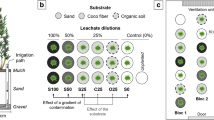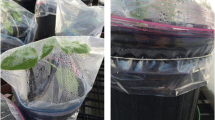Abstract
Uptake and translocation of chromium (Cr) by two willow species was investigated. Intact pre-rooted weeping willows (Salix babylonica L.) and hankow willows (Salix matsudana Koidz) were grown hydroponically and spiked with hexavalent chromium [Cr (VI)] or trivalent chromium [Cr (III)] at 25.0 ± 0.5°C for 120 h. Removal of leaves was also performed as a treatment to quantify the effect of transpiration on uptake and translocation of either of the Cr species. Although the two willow species were able to eliminate Cr (VI) and Cr (III) from the hydroponic solution, significant differences in the removal rate for both chemical species were observed between the two willows (p < 0.05): faster removal rate for Cr (III) than Cr (VI) was detected in both willow species; hankow willows showed higher removal potential for both chemical species than weeping willows. Remarkable decreases in the removal rates for both Cr species were detected in the willows with leaves removed (p < 0.05). The results from the treatments spiked with Cr (VI) also revealed that Cr was more mobile in plant materials of hankow willows than that in weeping willows (p < 0.01), while higher translocation efficiency of Cr was observed in weeping willows than hankow willows for the Cr (III) treated (p < 0.01). However, a convincing decrease in the translocation efficiency due to the removal of leaves was only observed in the treatments spiked with Cr (VI) (p < 0.05). Substantial differences existed in the distribution of Cr species in plant materials after exposure of either of the chemical forms: roots and lower stems were the major sites for accumulation in weeping willows exposed to Cr (VI) and Cr (III), respectively; in contrast roots were the only sink in hankow willows exposed to both chemical species. The capacity of willows to assimilate both Cr species was also evaluated using detached leaves and roots of both willow species in sealed glass vessels in vivo. The results indicated that detached roots showed a more remarkable capacity to remove Cr (III) from the hydroponic solution than Cr (VI) (p < 0.01). Although detached leaves of both willow species were able to efficiently eliminate Cr (III), neither of them reduced the concentration of Cr (VI) in the solution. The results suggests that different mechanisms for uptake, assimilation and translocation of Cr (VI) and Cr (III) exist in different willow species and phytoremediation of Cr should consider this factor for the proposed target effectively.




Similar content being viewed by others
References
Banks MK, Schwab AP, Henderson C (2006) Leaching and reduction of chromium in soil as affected by soil organic content and plants. Chemosphere 62:255–264
Cheung KH, Gu J-D (2003) Reduction of chromate (CrO 2−4 ) by an enrichment consortium and an isolate of marine sulfate-reducing bacteria. Chemosphere 52:1523–1529
Cheung KH, Gu J-D (2005) Chromate reduction by Bacillus megaterium TKW3 isolated from marine sediments. World J Microbiol Biotechnol 21:213–219
Cheung KH, Lai HY, Gu J-D (2006) Membrane-associated hexavalent chromium reductase of Bacillus megaterium TKW3 with induced expression. J Microbiol Biotechnol 16:855–862
Dixit V, Pandey V, Shyam R (2002) Chromium ions inactivate electron transport and enhance superoxide generation in vivo in pea (Pisum sativum L.cv. Azad) root mitochondria. Plant Cell Environ 25:687–693
Katz SA, Salem H (1994) The biological and environmental chemistry of chromium. VCH Publishers, New York
Khan AG (2001) Relationships between chromium biomagnification ratio, accumulation factor, and mycorrhizae in plants growing on tannery effluent-polluted soil. Envinon Int 26:417–423
Kimbrough DE, Cohen Y, Winer AM, Creelam L, Mabuni C (1999) A critical assessment of chromium in the environment. Crit Rev Environ Sci Technol 29:1–46
Kuffner M, Puschenreiter M, Wieshammer G, Gorfer M, Sessitsch A (2008) Rhizosphere bacteria affect growth and metal uptake of heavy metal accumulating willows. Plant Soil 304:35–44
Licina V, Antic-Mladenovic S, Kresovic M (2007) The accumulation of heavy metals in plants (Lactuca sativa L. Fragaria vesca L.) after the amelioration of coalmine tailing soils with different organo-mineral amendments. Arch Agric Soil Sci 53:39–48
McIntyre T (2003) Phytoremediation of heavy metals from soils. Adv Biochem Eng Biotechnol 78:97–123
Meers E, Hopgood M, Lesge E, Vervake P, Tack FMG, Verloo MG (2004) Enhanced phytoextraction: in search of EDTA alternatives. Int J Phytorem 6:95–109
Overesch M, Rinklebe J, Broll G, Neue HU (2007) Metals and arsenic in soils and corresponding vegetation at Central Elbe river floodplains (Germany). Environ Pollut 145:800–812
Quaggiotti S, Barcaccia G, Schiavon M, Nicole S, Galla G, Rossignolo V, Soattin M, Malagoli M (2007) Phytoremediation of chromium using Salix species: cloning ESTs and candidate genes involved in the Cr response. Gene 402:68–80
Ryan MP, Williams DE, Chater RJ, Hutton BM, McPhail DS (2002) Why stainless steel corrodes. Nature (London) 415:770–774
Shahandeh H, Hossner LR (2001) Plant screening for chromium phytoremediation. Int J Phytorem 2:31–51
Shanker AK, Cervantes C, Loza-Tavera H, Avudainayagam S (2005) Chromium toxicity in plants. Environ Int 31:739–753
Skeffington RA, Shewry PR, Petersen PJ (1976) Chromium uptake and transport in barley seedlings Hordeum vulgare. Planta 132:209–214
Trapp S, Zambrano KC, Kusk KO, Karlson U (2000) A phytotoxicity test using transpiration of willows. Arch Environ Contam Toxicol 39:154–160
Vajpayee P, Tripathi RD, Rai UN, Ali MB, Singh SN (2000) Chromium(VI) accumulation reduces chlorophyll biosynthesis, nitrate reductase activity and protein content in Nymphaea alba L. Chemosphere 41:1075–1082
Xu XR, Li HB, Gu J-D (2005a) Reduction of hexavalent chromium by ascorbic acid in aqueous solutions. Chemosphere 57:609–613
Xu XR, Li HB, Gu J-D, Li XY (2005b) Kinetics of the reduction of chromium (VI) by vitamin C. Environ Toxicol Chem 24:1310–1314
Yu XZ, Gu J-D (2006) Uptake, metabolism and toxicity of methyl tert-butyl ether (MTBE) in weeping willows. J Hazard Mater 137:1417–1423
Yu XZ, Gu J-D (2007a) Accumulation and distribution of trivalent chromium and effects on hybrid willow (Salix matsudana Koidz × alba L.) metabolism. Arch Environ Contam Toxicol 52:503–511
Yu XZ, Gu J-D (2007b) Metabolic responses of weeping willows to selenate and selenite. Env Sci Pollut Res 14:510–517
Yu XZ, Gu J-D (2008a) The role of EDTA in phytoextraction of hexavalent and trivalent chromium by two willow trees. Ecotoxicology 17:143–152
Yu XZ, Gu J-D (2008b) Effect of available nitrogen on photoavailability and bioaccumulation of hexavalent and trivalent chromium in hankow willows (Salix matsudana Koidz). Ecotoxicol Environ Saf 70:216–222
Yu XZ, Gu J-D, Huang SZ (2007) Hexavalent chromium induced stress and metabolic responses of in hybrid willows. Ecotoxicology 16:299–309
Yu XZ, Zhou PH, Yang YM (2006) The potential for phytoremediation of iron cyanide complex by willows. Ecotoxicology 15:461–467
Zayed AM, Lytle CM, Qian JH, Terry N (1998) Chromium accumulation, translocation and chemical speciation in vegetable crops. Planta 206:293–299
Acknowledgements
This work was supported in part by CAG HKUST 3/04C from Hong Kong Research Grant Council.
Author information
Authors and Affiliations
Corresponding author
Rights and permissions
About this article
Cite this article
Yu, XZ., Gu, JD. & Xing, LQ. Differences in uptake and translocation of hexavalent and trivalent chromium by two species of willows. Ecotoxicology 17, 747–755 (2008). https://doi.org/10.1007/s10646-008-0224-y
Received:
Accepted:
Published:
Issue Date:
DOI: https://doi.org/10.1007/s10646-008-0224-y




